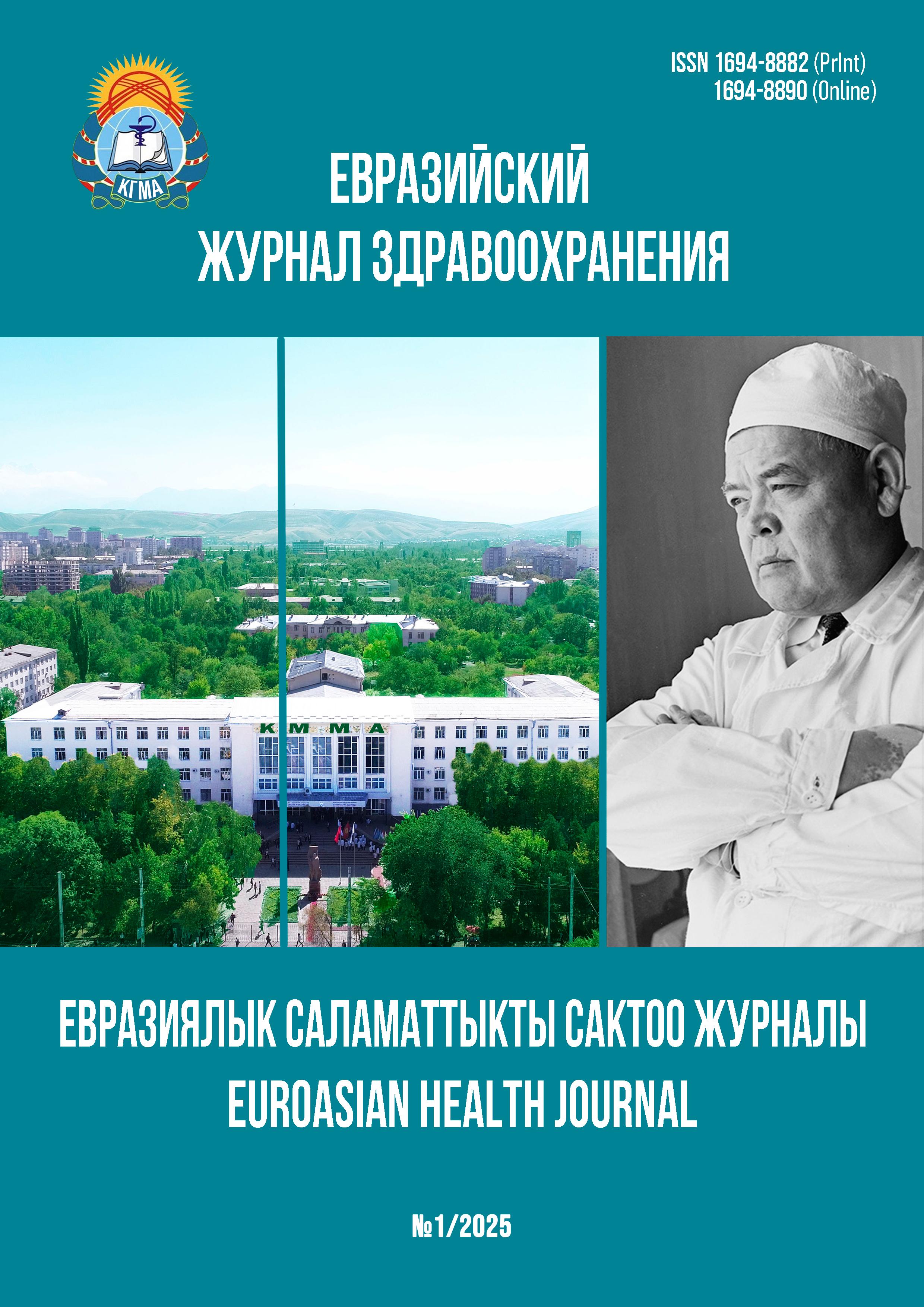CORRELATION OF CARDIOVASCULAR DISEASE RISK FACTORS WITH ARTERIAL VASCULAR STIFFNESS AND REFLECTED WAVE INDICES
DOI:
https://doi.org/10.54890/1694-8882-2025-1-74Abstract
Arterial stiffness measurements are currently used more for research purposes than in clinical practice. Increased arterial stiffness values provide direct evidence of target organ damage, with pulse wave velocity considered a biomarker of vascular injury and an important predictor of a patient's global cardiovascular risk, given that classical risk scores, mainly at intermediate risk, are poorly suited to predict cardiovascular outcomes. Traditional risk prediction models such as the Framingham risk score are commonly used to calculate individual risk for primary prevention of cardiovascular disease, but this assessment has limitations such as reduced accuracy in some ethnic groups and lack of inclusion of certain risk factors. Adding arterial stiffness parameters and pulse wave reflection metrics to classical cardiovascular risk stratification may move individuals into a higher risk category, implying changes in treatment aimed at higher cardiovascular protection. The review article presents data on the relationship between cardiovascular risk factors and arterial
stiffness indices and reflected wave parameters.
Keywords:
cardiovascular diseases, factors of cardiovascular diseases, arterial stiffness, reflected wave indicatorsReferences
1. Zhu Y, Liu C, Zhang L, Fang Q, Zang S, Wang X. How to control the economic burden of treating cardio-cerebrovascular diseases in China? Assessment based on System of Health Accounts 2011. J Glob Health. 2020;10(1):010802. https://doi.org/10.7189/jogh.10.010802
2. Li J, Liu W, Peng F, Cao X, Xie X, Peng C. The multifaceted biology of lncR-Meg3 in cardio-cerebrovascular diseases. Front Genet. 2023;14:1132884. https://doi.org/10.3389/fgene.2023.1132884
3. Nawsherwan, Bin W, Le Z, Mubarik S, Fu G, Wang Y. Prediction of cardiovascular diseases mortality- and disability-adjusted life-years attributed to modifiable dietary risk factors from 1990 to 2030 among East Asian countries and the world. Front Nutr. 2022;9:898978. https://doi.org/10.3389/fnut.2022.898978
4. Di Cesare M, Perel P, Taylor S, Kabudula C, Bixby H, Gaziano TA, et al. The Heart of the World. Glob Heart. 2024;19(1):11. https://doi.org/10.5334/gh.1288
5. Zhang K, Jiang Y, Zeng H, Zhu H. Application and risk prediction of thrombolytic therapy in cardio-cerebrovascular diseases: a review. Thromb J. 2023;21(1):90. https://doi.org/10.1186/s12959-023-00532-0
6. Lindstrom M, DeCleene N, Dorsey H, Fuster V, Johnson CO, LeGrand KE, et al. Global Burden of Cardiovascular Diseases and Risks Collaboration, 1990-2021. J Am Coll Cardiol. 2022;80(25):2372-2425. https://doi.org/10.1016/j.jacc.2022.11.001
7. Di Cesare M, Perel P, Taylor S, Kabudula C, Bixby H, Gaziano TA, et al. The Heart of the World. Glob Heart. 2024;19(1):11. https://doi.org/10.5334/gh.1288
8. Budoff MJ, Alpert B, Chirinos JA, Fernhall B, Hamburg N, Kario K, et al. Clinical Applications Measuring Arterial Stiffness: An Expert Consensus for the Application of Cardio-Ankle Vascular Index. Am J Hypertens. 2022;35(5):441-453. https://doi.org/10.1093/ajh/hpab178
9. Nichols WW, Denardo SJ, Wilkinson IB, McEniery CM, Cockcroft J, O'Rourke MF. Effects of arterial stiffness, pulse wave velocity, and wave reflections on the central aortic pressure waveform. J Clin Hypertens (Greenwich). 2008;10(4):295-303. https://doi.org/10.1111/j.1751-7176.2008.04746.x
10. Pierce GL, Coutinho TA, DuBose LE, Donato AJ. Is It Good to Have a Stiff Aorta with Aging? Causes and Consequences. Physiology (Bethesda). 2022;37(3):154-173. https://doi.org/10.1152/physiol.00035.2021
11. Agbaje AO. Arterial stiffness precedes hypertension and metabolic risks in youth: a review. J Hypertens. 2022;40(10):1887-1896. https://doi.org/10.1097/ HJH.0000000000003239
12. Цой Л.Г., Сабиров И.С., Полупанов А.Г. Состояние эндотелиальной функции у больных ишемической болезнью сердца пожилого возраста, осложненной хронической сердечной недостаточностью в процессе лечения бета-блокатором бисопрололом. Вестник Кыргызско-Российского Славянского университета. 2021;21(1):93-97.
13. Scicchitano P, Cortese F, Gesualdo M, De Palo M, Massari F, Giordano P, et al. The role of endothelial dysfunction and oxidative stress in cerebrovascular diseases. Free Radic Res. 2019;53(6):579-595. https://doi.org/10.1080/10715762.2019. 1620939
14. Полупанов А.Г., Залова Т.Б., Рысматова Ф.Т., Дуйшеналиева М.Т., Романова Т.А., Джумагулова А.С. Взаимосвязь концентрации фактора некроза опухоли альфа и интерлейкина-10 с развитием фатальных и нефатальных осложнений у больных эссенциальной гипертензией в процессе среднесрочного наблюдения. Артериальная гипертензия. 2019;25(5):540–548. https://doi.org/10.18705/1607-419X-2019-25-5-540-54
15. Su JH, Luo MY, Liang N, Gong SX, Chen W, Huang WQ, et al. Interleukin-6: A Novel Target for Cardio-Cerebrovascular Diseases. Front Pharmacol. 2021;12:745061. https://doi.org/10.3389/fphar.2021.745061
16. Kim HL. Arterial stiffness and hypertension. Clin Hypertens. 2023;29(1):31. https://doi.org/10.1186/s40885-023-00258-1
17. Kalra L, Rambaran C, Chowienczyk P, Goss D, Hambleton I, Ritter J, et al. Ethnic differences in arterial responses and inflammatory markers in Afro-Caribbean and Caucasian subjects. Arterioscler Thromb Vasc Biol. 2005;25(11):2362-2367. https://doi.org/10.1161/01.ATV.0000183887.76087.6a
18. McNally RJ, Boguslavskyi A, Malek R, Floyd CN, Cecelja M, Douiri A, et al. Influence of Blood Pressure Reduction on Pulse Wave Velocity in Primary Hypertension: A Meta-Analysis and Comparison With an Acute Modulation of Transmural Pressure. Hypertension. 2024;81(7):1619-1627.https://doi.org/10.1161/HYPERTENSIONAHA.123.22436
19. Mitchell GF, Guo CY, Benjamin EJ, Larson MG, Keyes MJ, Vita JA, et al. Cross-sectional correlates of increased aortic stiffness in the community: the Framingham Heart Study. Circulation. 2007;115(20):2628-2636. https://doi.org/10.1161/ CIRCULATIONAHA.106.667733
20. Karaki M, Kunimatsu N, Watanabe K, Tomoto T, Fukuie M, Sugawara J, et al. The validity of carotid-femoral pulse wave velocity in the seated posture as an index of central arterial stiffness. Am J Physiol Regul Integr Comp Physiol. 2025;328(2):R145-R153. https://doi.org/10.1152/ajpregu.00073.2024
21. Brillante DG, O'Sullivan AJ, Howes LG. Arterial stiffness indices in healthy volunteers using non-invasive digital photoplethysmography. Blood Press. 2008;17 (2):116-123. https://doi.org/10.1080/08037050802059225
22. Garoffolo G, Pesce M. Vascular dysfunction and pathology: focus on mechanical forces. Vasc Biol. 2021;3(1):R69-R75. Published 2021 Jun 9. https://doi.org/ 10.1530/VB-21-0002
23. Schiffrin EL. Vascular stiffening and arterial compliance. Implications for systolic blood pressure. Am J Hypertens. 2004;17(12 Pt 2):39S-48S. https://doi.org/ 10.1016/j.amjhyper.2004.08.019
24. Safar ME. Pulse pressure, arterial stiffness, and cardiovascular risk. Curr Opin Cardiol. 2000;15(4):258-263. https://doi.org/10.1097/00001573-200007000-00009
25. MacMahon SW, Macdonald GJ. Antihypertensive treatment and plasma lipoprotein levels. The associations in data from a population study. Am J Med. 1986;80(2A):40-47. https://doi.org/10.1016/0002-9343(86)90159-2
26. Cooney MT, Vartiainen E, Laatikainen T, Juolevi A, Dudina A, Graham IM. Elevated resting heart rate is an independent risk factor for cardiovascular disease in healthy men and women [published correction appears in Am Heart J. 2010 Jul;160(1):208. Laakitainen, Tinna [corrected to Laatikainen, Tiina]. Am Heart J. 2010;159(4):612-619.e3. https://doi.org/10.1016/j.ahj.2009.12.029
27. Kase M, Iijima T, Niitani T, Sagara M, Sakurai S, Tomaru T, et al. Relationship between reduced heart rate variability and increased arterial stiffness evaluated by the cardio-ankle vascular index in people with type 2 diabetes. Diabetol Int. 2022;14(1):94-102. Published 2022 Sep 29. https://doi.org/10.1007/s13340-022-00604-y
28. Park BJ, Lee HR, Shim JY, Lee JH, Jung DH, Lee YJ. Association between resting heart rate and arterial stiffness in Korean adults. Arch Cardiovasc Dis. 2010;103(4):246-252. https://doi.org/10.1016/j.acvd.2010.03.004
29. DuPont JJ, Kenney RM, Patel AR, Jaffe IZ. Sex differences in mechanisms of arterial stiffness. Br J Pharmacol. 2019;176(21):4208-4225. https://doi.org/10.1111 /bph.14624
30. Naka KK, Papathanassiou K, Bechlioulis A, Kazakos N, Pappas K, Tigas S, et al. Determinants of vascular function in patients with type 2 diabetes. Cardiovasc Diabetol. 2012;11:127. https://doi.org/10.1186/1475-2840-11-127
31. Staef M, Ott C, Kannenkeril D, Striepe K, chiffer M, Schmieder RE, Bosch A. Determinants of arterial stiffness in patients with type 2 diabetes mellitus: a cross sectional analysis. Sci Rep. 2023;13:8944. https://doi.org/10.1038/s41598-023-35589-4
32. Li Y, Liu Y, Liu S, Gao M, Wang W, Chen K, et al. Diabetic vascular diseases: molecular mechanisms and therapeutic strategies. Signal Transduct Target Ther. 2023;8(1):152. https://doi.org/10.1038/s41392-023-01400-z
33. Karabaeva RZ, Vochshenkova TA, Mussin NM, Albayev RK, Kaliyev AA, Tamadon A. Epigenetics of hypertension as a risk factor for the development of coronary artery disease in type 2 diabetes mellitus. Front Endocrinol (Lausanne). 2024;15:1365738. https://doi.org/10.3389/fendo.2024.1365738
34. Tsioufis C, Dimitriadis K, Selima M, Thomopoulos C, Mihas C, Skiadas I, et al. Low-grade inflammation and hypoadiponectinaemia have an additive detrimental effect on aortic stiffness in essential hypertensive patients. Eur Heart J. 2007;28(9):1162-1169. https://doi.org/10.1093/eurheartj/ehm089
35. Jerrard-Dunne P, Mahmud A, Feely J. Ambulatory arterial stiffness index, pulse wave velocity and augmentation index--interchangeable or mutually exclusive measures? J Hypertens. 2008;26(3):529-534. https://doi.org/10.1097/HJH. 0b013e3282f35265
36. Williams B, Mancia G, Spiering W, Agabiti Rosei E, Azizi M, Burnier M, et al. 2018 ESC/ESH Guidelines for the management of arterial hypertension: The Task Force for the management of arterial hypertension of the European Society of Cardiology and the European Society of Hypertension: The Task Force for the management of arterial hypertension of the European Society of Cardiology and the European Society of Hypertension [published correction appears in J Hypertens. 2019 Jan;37(1):226. https://doi.org/10.1097/HJH.0000000000002017.]. J Hypertens. 2018;36(10):1953-2041. https://doi.org/10.1097/HJH.0000000000001940
37. Loehr LR, Meyer ML, Poon AK, Selvin E, Palta P, Tanaka H, et al. Prediabetes and Diabetes Are Associated With Arterial Stiffness in Older Adults: The ARIC Study. Am J Hypertens. 2016;29(9):1038-1045. https://doi.org/10.1093/ajh/hpw036
38. Vatner SF, Zhang J, Vyzas C, Mishra K, Graham RM, Vatner DE. Vascular Stiffness in Aging and Disease. Front Physiol. 2021;12:762437. https://doi.org/10.3389/ fphys.2021.762437
39. Kim JM, Kim SS, Kim IJ, Kim JH, Kim BH, Kim MK, et al. Arterial stiffness is an independent predictor for risk of mortality in patients with type 2 diabetes mellitus: the REBOUND study. Cardiovasc Diabetol. 2020;19(1):143. Published 2020 Sep 22. https://doi.org/10.1186/s12933-020-01120-6
40. Din JN, Ashman OA, Aftab SM, Jubb AW, Newby DE, Flapan AD. Increased arterial stiffness in healthy young South Asian men. J Hum Hypertens. 2006;20(2):163-165. https://doi.org/10.1038/sj.jhh.1001961
41. Pinto ES, Mensah R, Meeran K, Cameron JD, Murugaesu N, Bulpitt CJ, et al. Peripheral arterial compliance differs between races: comparison among Asian, Afro-Caribbeans, and white Caucasians with type 2 diabetes. Diabetes Care. 2005;28(2):496. https://doi.org/10.2337/diacare.28.2.496
42. Polupanov AG, Khalmatov AN, Altymysheva AT, Lunegova OS, Mirrakhimov AE, Sabirov IS, et al. The prevalence of major cardiovascular risk factors in a rural population of the chui region of Kyrgyzstan: the results of an epidemiological study. The Anatolian Journal of Cardiology. 2020;24(3):183-191. https://doi.org/ 10.14744/AnatolJCardiol.2020.59133







